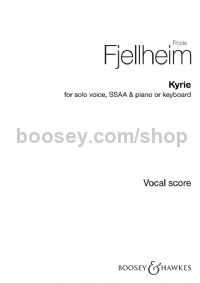Kyrie (Solo male voice, SSAA & Piano)
Kyrie (Solo male voice, SSAA & Piano)
Bulk Discounts Available
* Estimated price converted from UK retail price
Composer's Note
Kyrie, in the original version, was a part of my album called Biejjien vuelie – Solkvad. ‘Biejjien vuelie’ means ‘Yoik of the sun’ in South Sámi language. Solkvad (or Sólarljóþ in the original Norse language), is a poem that I found in the old Norse poem collection Den eldre Edda. The music on the album was inspired by both the Norse poems and the Sámi yoik tradition.
The Sámi culture is mentioned in several places in the old Sagas, and indicates that the society in the Nordic countries around year 1000 was indeed multi cultural. The poems I selected from the Norse literature had a certain sacred atmosphere, so on the album I wanted to combine them with elements from the Latin Mass. This Kyrie is one example of that. There are perhaps no Norse elements in it, but a strong influence from the Sámi yoik tradition. The album version from 2013 included a band, soloists and a SATB choir. This SSAA version was made for the choir Cantus and their album Northern Lights in 2017.
The words ‘Kyrie eleison’ are used both in Latin and South Sámi language. The Sámi version, ‘Kyrie eelejson’, has another rhythm and the syllables are stressed differently. In Sámi language the first syllable in eelejson (ee – long e, as in ever) has a pronounced stress and is the reason for the rhythmical idea for the first melodic phrase (bars 5–6 with a Latin rhythm, bars 7–8 the same with a Sámi rhythm).
In bar 65–80 the soloist may perform the music as written, or improvise more freely using the syllables and given tonality as a starting point. A male soloist makes a nice contrast to the choir, but a female soloist may be used. The following can be used as a guide to pronunciation:
å – as in ‘all’
a – as in ‘far’
e – as in ‘bed’
j – as in ‘yes’
Frode Fjellheim - 2017




